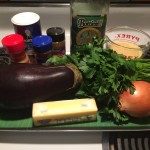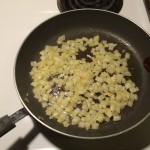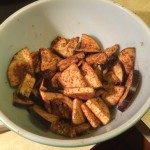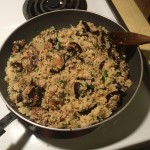 This Meatless Monday, we have a great recipe for eggplant – Moroccan Couscous and Eggplant – with growing, storage and prep tips, from Vermont Fresh: A Fruit and Vegetable Handbook.
This Meatless Monday, we have a great recipe for eggplant – Moroccan Couscous and Eggplant – with growing, storage and prep tips, from Vermont Fresh: A Fruit and Vegetable Handbook.
Jonathan Taft-Dick, a volunteer cooking, tasting and testing recipes out of the Vermont Fresh Handbook tested this recipe. His comments are in italics below.
Background
Although eggplant is often associated with Italy due to the famous eggplant Parmesan, it actually originated in southeast Asia. Also called aubergine, eggplant didn’t spread to Europe until the 16th century. The Spanish called the odd-looking fruit the “apple of love,” as they believed it to be an aphrodisiac. In contrast, the more suspicious British called it the “mad apple”—as part of the poisonous nightshade family, eggplant was originally suspected of being detrimental to health. The earlier varieties of eggplant may have been more bitter than those that are popular today. There are many varieties of eggplant, from the well-known purple, oblong fruit to small, white ones that look like eggs. The eggplants that are popular in the United States today were developed for their size and ability to hide bruises. Other cultures value eggplants of different sizes, shapes, and colors.
Growing Tips
Eggplants like it hot! Seeds should be started indoors 2-3 months before planting outside (which you should do after all danger of frost has passed and the ground has warmed). Seeds germinate best at very warm temperatures. To boost the temperatures around the plants, you may wish to use black plastic mulch and/or floating row cover. Some Vermonters have even had success growing eggplants in large pots set atop their paved driveways! Take care not to over-fertilize, as that will cause plants to produce more leaves than fruit. Harvest eggplants when their skin becomes shiny and your fingerprints don’t leave an impression on the fruit. To avoid slowing production, harvest regularly. Brown seeds indicate overripe fruit.
Storage
Eggplants are relatively fragile despite their sturdy appearance. They are best when used as soon as possible, but if the skin is undamaged, they will keep for about a week in the refrigerator (or a few days out of it). To freeze: rinse, cut off both ends, and peel the fruit. Cut into half-inch thick slices and boil in 1 gallon water plus 1 cup lemon juice for 4 minutes. Chill slices in ice water, drain, and pack into freezer bags.
Nutritional Benefits
Eggplant is high in fiber and potassium. It is also a good source of vitamin B6, folate, magnesium, and niacin. Furthermore, eggplant has phytochemicals that are believed to help protect the body against lifetime illnesses.
Preparation
Whether or not you peel the eggplant is purely a matter of personal preference, though some larger fruits will have tough skins. Before frying eggplant, many cooks like to “sweat” it, which means sprinkling cut-up pieces with salt, letting them sit for 30 minutes, then rinsing with water. This has the effect of tenderizing the flesh slightly. Eggplant can be baked, roasted, fried, sautéed, and steamed.
Meatless Monday Recipe: Moroccan Couscous and Eggplant
Serves 4
(adapted from Leanne Kitchen: The Produce Bible)
Ingredients
- 1 eggplant
- 3/4 cup olive oil
- 1 onion, chopped
- 3 teaspoons cumin
- ¼ teaspoon cinnamon
- 1 teaspoon paprika
- ½ teaspoon salt
- 3 tablespoons butter
- 1 handful fresh parsley, chopped (optional)
Instructions
- Put couscous in large, heat-proof bowl with 1½ cups boiling water. Let stand 10 minutes, then fluff.
- Pour a few teaspoons olive oil into heavy fry pan, using enough to coat the bottom Heat oil, then add onion and cook until browned. Transfer onions to a bowl.
- Slice eggplant into half-inch rounds, then chop those into bite-sized pieces. Toss pieces with spices and salt.
- Add remaining oil to the fry pan and heat. Fry eggplant until browned, about 20 minutes. Remove eggplant to bowl with onions.
- Melt butter in fry pan, add couscous, and cook until warm. Stir in eggplant, onion, and parsley. Serve at room temperature.
- Photo courtesy of Jonathan Taft-Dick
- Photo courtesy of Jonathan Taft-Dick
- Photo courtesy of Jonathan Taft-Dick
- Photo courtesy of Jonathan Taft-Dick
- Photo courtesy of Jonathan Taft-Dick
Comments from Jonathan:
My only complaint right off the bat with this recipe is it doesn’t give the amount of couscous that you are supposed to use for the recipe. However, at the COOP where I purchased it, the instructions for cooking couscous said 1 cup for every 1.5 cups of boiling water. Since this recipe called for putting 1.5 cups of boiling water in with the couscous I figured that I needed a cup of couscous!
Couscous is very cheap, I paid less than a dollar for a cup of couscous. It’s also a lot quicker than boiling rice, since it only takes 10 minutes.
In terms of cost this recipe is very inexpensive. However, I already had a bottle of olive oil ($6-$20), cumin ($2-$10), paprika ($4-$10), cinnamon ($3-$8) and salt and butter. So all I had to purchase at the COOP was an eggplant ($2), an onion ($1), and a bunch of parsley ($1.80).
In terms of preparing for the recipe, I spent about 10 minutes chopping the onion, eggplant, and parsley. I covered the eggplant in the spices while sauteeing the onion. Once the onion was browned (roughly 8-10 minutes), I threw in the eggplant.
I would probably use a little more oil since the eggplant seemed to soak up all the oil and the pan felt a little dry.
Right when I started sauteeing the eggplant I boiled the water for the couscous, and then soaked the couscous in that boiled water. Sure enough they plumped right up in less than 10 minutes. I also loved the butter melted into the couscous.
From start to finish I spent a little over a half hour on this recipe. Very easy and straight forward! I also haven’t had couscous in a while and I found I really liked it! I also don’t necessarily care for eggplant however I was pleasantly surprised that I really enjoyed it! The coating of the spices add a lot of levels of flavor. My only complaint would be with the texture of this dish; everything was soft, so the bites were a little “mushy.” However, I would definitely do this recipe again because it’s very easy, does not take a lot of time, and if you already have the spices its extremely cheap. It also does feed 4 people! It was only my father and I but we each had leftovers the next day.
To receive more recipes and tips on your favorite fruits and vegetables, download Vermont Fresh: A Fruit and Vegetable Handbook. We also need more volunteer home chefs for this project.
Vermont Foodbank fresh food initiatives would not be possible without your support. Please consider giving to the Vermont Foodbank today!





